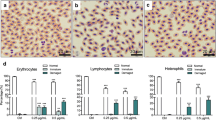Abstract
Lead exposure causes neurotoxicity, reproductive system dysfunction, renal failure, and blood and endocrine system disorders in human and experimental animals. In this study, we investigated lead mobilization from gunshot fragments to the critical organs (brain, heart, liver, and kidney) and its interaction with essential trace elements on experimental rat model. Thirty-five rats were randomly divided in five groups. The first group was a control and the others were subjected to buckshot implantation in their skeletal muscles (second and third groups) and abdomen (fourth and fifth groups). The control group and the second and fourth groups were sacrificed 1 month after the onset of experiment while the third and fifth groups were followed after 2 months. Blood lead levels were significantly elevated in both 2 month-followed groups and 1 month-followed intraabdominal group. There were significant increases in brain lead levels of both 2 month-followed groups. For the 1 month-followed groups, kidney lead levels were also significantly higher than those of controls. Results show that lead mobilizes from the buckshot residues in distance tissues to the critical organs and interacts with iron, copper, and zinc even though blood lead level sometimes remains unchanged. Our findings are crucial in revealing lead accumulation in critical organs of subjects carrying any gunshot fragments. These subjects and physicians should be in alert for emergence of lead-induced manifestations.
Similar content being viewed by others
References
Meggs WJ, Gerr F, Aly MH et al (1994) The treatment of lead poisoning from gunshot wounds with succimer (DMSA). Toxicol Clin Toxicol 32:377–385
Papanikolaou NC, Hatzidaki EG, Belivanis S, Tzanakakis GN, Tsatsakis AM (2005) Lead toxicity update. A brief review. Med Sci Monit 11(10):329–336
Sanborn MD, Abelsohn A, Campbell M, Weir E (2002) Identifying and managing adverse environmental health effects: 3. Lead exposure. CMAJ 166(10):1287–1292
Loghman-Adham M (1997) Renal effects of environmental and occupational lead exposure. Environ Health Perspect 05(9):928–938
Dillman RO, Crumb CK, Lidsky MJ (1979) Lead poisoning from a gunshot wound. Report of a case and review of the literature. Am J Med 66:509–514
Dasani BM, Kawanishi H (1994) The gastrointestinal manifestations of gunshot-induced lead poisoning. J Clin Gastroenterol 19:296–299
Aly MH, Kim HC, Renner SW et al (1993) Hemolytic anemia associated with lead poisoning from shotgun pellets and the response to succimer treatment. Am J Hematol 44:280–283
Fiorica V, Brinker JE (1989) Increased lead absorption and lead poisoning from a retained bullet. J Okla State Med Assoc 82:63–67
Scuderi GJ, Vaccaro AR, Fitzhenry LN et al (2004) Long-term clinical manifestations of retained bullet fragments within the intervertebral disk space. J Spinal Disord Tech 17:108–111
Coon T, Miller M, Shirazi F et al (2006) Lead toxicity in a 14-year-old female with retained bullet fragments. Pediatrics 117:227–230
John BE, Boatright D (1999) Lead toxicity from gunshot wound. S Med J 92:223–224
Nguyen A, Schaider JJ, Manzanares M et al (2005) Elevation of blood lead levels in emergency department patients with extra-articular retained missiles. J Trauma 58:289–299
López CM, Piñeiro AE, González DE et al (1998) Variations in rat biochemical parameters after buckshot implant. Farmaco 53:209–213
Gerhardsson L, Dahlin L, Knebel R et al (2002) Blood lead concentration after a shotgun accident. Environ Health Perspect 110:115–117
Ernst JA, Neal PR (1992) Minerals and trace elements. In: Polin RA, Fox WW (eds) Fetal and neonatal physiology. W.B. Saunders Co, Philadelphia, pp 239–247
Lauwerys RR (1982) Toxicologie endustrielle et intoxications professionneles. Deuxime edn, Masdon, Paris, p 143
Miller GD, Massaro TF, Massaro EJ (1990) Interactions between lead and essential elements: a review. Neurotoxicology 11:99–119
Gasiorowski K, Pawlowski T, Spychala J et al (1987) The influence of subcutaneously administered lead (II) acetate on the concentrations of copper, iron, and zinc in the blood, kidney, liver, and spleen of rats. Sci Total Environ 64:117–123
Evenson MA, Anderson T (1975) Ultra-microanalysis for copper, cadmium and zinc human liver tissue by use of atomic absorption spectrophotometry and the heated graphite tube atomizer. Clin Chem 21:537–543
Karakoc Y, Yurdakos E, Gulyasar T et al (2003) Experimental stress-induced changes in trace element levels of various tissues in rats. J Trace Elem Exp Med 16:55–60
Gulyasar T, Aydogdu N, Cakina S et al (2010) Trace elements in a rat model of cadmium toxicity: the effects of taurine, melatonin and n-acetylcysteine. Trakya Univ Tip Fak Derg 27:23–27
Magos L (1994) Lead poisoning from retained lead projectiles. A critical review of case reports. Hum Exp Toxicol 13:735–742
Nowak B, Chmielnicka J (2000) Relationship of lead and cadmium to elements in hair, teeth, and nails of environmentally exposed people. Ecotoxicol Environ Saf 46:265–274
Author information
Authors and Affiliations
Corresponding author
Rights and permissions
About this article
Cite this article
Celbis, O., Karakoc, Y., Ozdemir, B. et al. Investigation of Lead Mobilization from the Buckshot Residues to the Critical Organs. Biol Trace Elem Res 143, 688–694 (2011). https://doi.org/10.1007/s12011-010-8907-7
Received:
Accepted:
Published:
Issue Date:
DOI: https://doi.org/10.1007/s12011-010-8907-7




